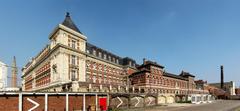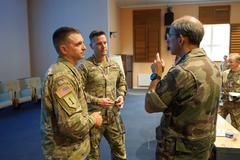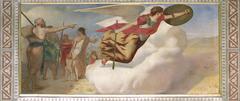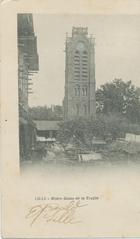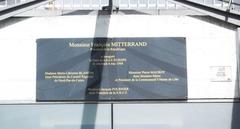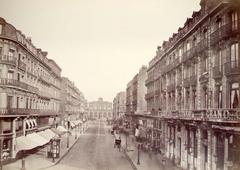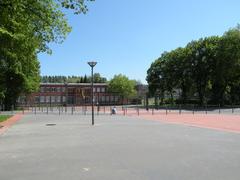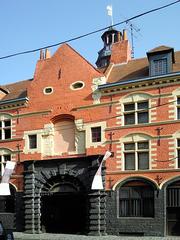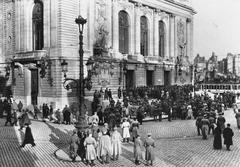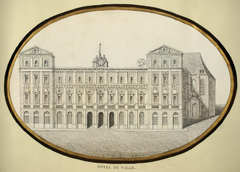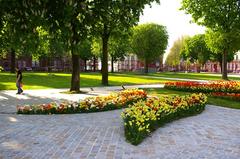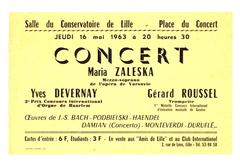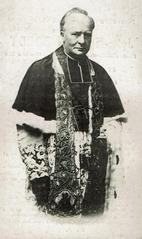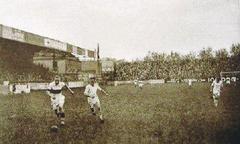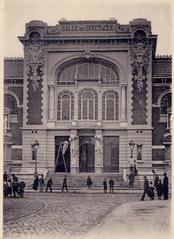Institut Industriel du Nord Lille: Visiting Hours, Tickets, and Historical Sites Guide
Date: 14/06/2025
Introduction
Nestled in Lille, France, the Institut Industriel du Nord (IDN)—now the prestigious École Centrale de Lille—stands as a cornerstone of the region’s industrial, educational, and architectural heritage. Founded in 1872, the IDN pioneered a rigorous engineering education model, combining theoretical knowledge with hands-on practical training. Over nearly 150 years, its historic buildings and modern campus have reflected the evolution of engineering education and scientific innovation in northern France.
This guide provides a comprehensive overview for visitors: historical context, ticketing and access details, practical travel tips, and highlights of nearby attractions. Whether you are a history buff, student, or curious traveler, use this resource to plan an enriching experience at one of Lille’s emblematic sites. For the latest updates, consult the École Centrale de Lille official website and the Lille Tourist Office.
Table of Contents
- Introduction
- Historical Background
- Architectural and Educational Significance
- Visitor Information
- Nearby Attractions
- Practical Tips
- Frequently Asked Questions (FAQ)
- Conclusion
- References and Further Reading
Historical Background
Foundation and Early Years
The Institut Industriel du Nord was founded in 1872, succeeding the École des Arts Industriels et des Mines de Lille (est. 1854). Its establishment responded to the rapid industrialization of northern France, with the aim of training engineers for booming sectors such as textiles, mining, and metallurgy. Visionary figures like Louis Pasteur and Charles Frédéric Kuhlmann helped shape its early curriculum and research ethos (lilledantan.com).
Educational Model and Growth
Inspired by the German Technische Hochschule, IDN’s program uniquely combined academic rigor with extensive practical training. The multidisciplinary curriculum encompassed civil and mechanical engineering, chemistry, and material sciences, setting a new standard for technical education in France. Originally located on rue du Lombard, the institute soon moved to a custom-built facility on rue Jeanne-d’Arc in the Saint-Michel district to accommodate its growing student body (lilledantan.com; Wikidata).
Integration and Modernization
In 1968, IDN relocated to the Cité Scientifique campus in Villeneuve-d’Ascq, integrating with the University of Science and Technology of Lille. This move fostered interdisciplinary collaboration and provided access to state-of-the-art facilities. In 1991, the institution became École Centrale de Lille, joining the national network of Écoles Centrales and expanding its reputation internationally.
Architectural and Educational Significance
The original IDN buildings in the Saint-Michel district are notable examples of late 19th-century academic architecture, designed for both prestige and functionality. These facilities housed advanced laboratories, lecture halls, and workshops, reflecting Lille’s industrial ambitions. The modern campus in Villeneuve-d’Ascq, established in 1968, allowed the institution to scale up research and teaching, reinforcing its leadership in engineering education (about-france.com).
IDN and its successor, École Centrale de Lille, have produced generations of engineers who contributed significantly to the industrial growth of Lille and the Hauts-de-France region, especially in sectors like textiles, metallurgy, and mechanical engineering.
Visitor Information
Visiting Hours and Tickets
Historic Sites (Saint-Michel District, rue Jeanne-d’Arc):
- Interior Access: The original buildings are not open to the public for interior visits.
- Exterior Viewing: The façades and surrounding academic district are accessible for external viewing at any time. No tickets are required.
Modern Campus (Villeneuve-d’Ascq):
- Campus Access: The campus is generally open during daylight hours. Specific buildings and labs require authorization; public spaces are accessible.
- Guided Tours: Special events such as European Heritage Days (Journées du Patrimoine) or open days may include guided tours. Advance registration may be required.
- Tickets: Entry is free for public areas; special tours may charge a nominal fee or require registration.
For up-to-date schedules and ticketing, consult the École Centrale de Lille website or the Lille Tourist Office.
How to Get There
Saint-Michel District:
- By Metro/Transit: Easily reachable via Lille’s public transport; closest stops are in central Lille, followed by a brief walk.
- On Foot: Walkable from Lille’s city center, making for a pleasant stroll through historical neighborhoods.
Villeneuve-d’Ascq Campus:
- By Metro: Take Lille Metro Line 1 to “Cité Scientifique – Professeur Gabillard” (yellow line). The campus is a short walk from the station (Eupedia).
- By Tram: The Mongy tram lines also serve the university zone.
- By Car: Accessible via A1 and A27 motorways; on-campus parking is available, though limited during peak hours.
- From Lille-Lesquin Airport: About 10 km from campus; use taxi, shuttle, or public transit to reach Lille center, then transfer to metro or tram.
Guided Tours and Special Events
- Open Days & Heritage Events: The campus occasionally offers guided tours during open house events or European Heritage Days. These include historical displays, access to select laboratories, and meetings with faculty and students.
- Walking Tours: The Lille Tourist Office provides walking tours that may include the Saint-Michel district and its academic landmarks (en.lilletourism.com).
Accessibility
- Mobility: Both the Villeneuve-d’Ascq campus and public spaces in central Lille are wheelchair accessible, with ramps, elevators, and designated parking.
- Language: French is predominant, but English is widely available in tourist areas and at the university.
- Assistance: Contact the school or tourist office in advance for specific accessibility requirements.
Nearby Attractions
- Grand Place: Lille’s iconic central square, bustling with historic buildings and cafes (planetware.com).
- Palais des Beaux-Arts: One of France’s premier fine arts museums.
- Old Lille (Vieux Lille): Charming cobblestone streets, Flemish architecture, and vibrant culture.
- LaM (Lille Métropole Museum of Modern, Contemporary and Outsider Art): Located in Villeneuve-d’Ascq, within walking distance of the university campus (World Travel Guide).
- La Piscine Museum: An art and industry museum in nearby Roubaix (planetware.com).
- Maison Folie Wazemmes: Cultural center housed in a former textile mill.
Practical Tips
- Dining: On-campus cafeterias offer affordable meals; nearby V2 shopping center in Villeneuve-d’Ascq has a variety of restaurants.
- Public Transport: Lille’s metro, tram, and bus network is efficient and visitor-friendly. Single fares start at €1.80; day passes and multi-trip tickets are available (Eupedia).
- Weather: Lille has a temperate climate; pack an umbrella for occasional rain.
- Best Visiting Time: The campus is most lively during the academic year (September–June). For special events, plan around open days or European Heritage Days.
- Accommodation: Options range from city center hotels such as Hôtel L’Arbre Voyageur and L’Hermitage Gantois (Dreaming in French Blog) to Villeneuve-d’Ascq guesthouses.
Frequently Asked Questions (FAQ)
Q: Can I visit the interior of the original IDN buildings?
A: No, interior access is typically not permitted; however, the exterior can be viewed and photographed.
Q: Are there guided tours available?
A: Yes, but only during special events or by advance arrangement. Check official channels for dates and registration.
Q: Do I need tickets to visit?
A: No tickets are required for public areas or exterior viewing. Special events may require registration or a nominal fee.
Q: Is the campus accessible for visitors with reduced mobility?
A: Yes, both the central Lille area and Villeneuve-d’Ascq campus are wheelchair accessible.
Q: What is the best way to reach the campus from the city center?
A: The metro (Line 1) is the fastest and most convenient option.
Conclusion
The Institut Industriel du Nord, now École Centrale de Lille, embodies Lille’s legacy as a center of industrial innovation and engineering education. While the original historic buildings are best appreciated from the outside, the modern campus in Villeneuve-d’Ascq offers occasional guided tours and special events that open a window onto the institution’s remarkable past and vibrant present. Enrich your visit by exploring Lille’s nearby cultural and historical attractions, and leverage digital tools like the Audiala app for an interactive experience.
For updates on visiting hours, event schedules, and tour bookings, refer to the École Centrale de Lille official website and the Lille Tourist Office.
References and Further Reading
- Visiting the Historic Institut Industriel du Nord in Lille: Hours, Tickets, and Heritage, 2025, École Centrale de Lille (https://www.ec-lille.fr)
- Institut Industriel du Nord History, Heritage, and Visitor Information in Lille, 2025, École Centrale de Lille (https://centralelille.fr/en/centrale-lille/histoire-de-centrale-lille/)
- Visiting the Institut Industriel du Nord in Lille: History, Visitor Info & Nearby Attractions, 2025, Lille Tourism (https://en.lilletourism.com/)
- Practical Visitor Tips for École Centrale de Lille: Visiting Hours, Tickets & Villeneuve d’Ascq Historical Sites, 2025, École Centrale de Lille (https://centralelille.fr/)
- lilledantan.com
- Wikidata
- about-france.com
- planetware.com
- thecrazytourist.com
- World Travel Guide
- Dreaming in French Blog
- Lonely Planet
- Eupedia
